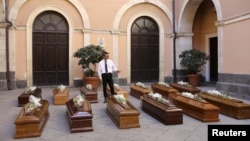For many years Eritreans tried to flee to Israel. Many were abducted, raped, tortured and held for ransom in the Sinai. Their kidnappers used the cell phones of their victims to demand ransoms from families.
Meron Estefanos has tracked the flight of Eritreans, a trail that shifted to the shores of Europe about two years ago. She has never taken the migrant’s hazardous trek from Eritrea to Europe. She grew up in Sweden and works for the International Commission on Eritrean Refugees in Stockholm. Her job is to interview Eritrean migrants for satellite broadcast to an Eritrean audience on Radio Erena.
She says she hopes her reports will persuade her countrymen that they should avoid the risks of migration and stay home. Nevertheless, Meron criticizes the government in Asmara for a military conscription that drives large numbers of unaccompanied minors to ignore her advice.
Broadcasting a discouraging word
“A lot of people do not see a future in Eritrea,” she says. “Over 4,000 unaccompanied minors – Eritrean minors- made it to Europe. What I see when I speak to these young unaccompanied minors is they are every realistic. They know the kind of future that is awaiting them, so that in a few years they will be soldiers like their fathers, like their older siblings, so they think fleeing is a solution.”
World attention became riveted on the migrant flow to Europe this spring when more than 2,000 refugees drowned in the Mediterranean. Then the European Union began to debate how to handle the thousands who reach the shores of Malta, Italy and Greece.
But for young Eritreans, the trip starts at their southern border where Ethiopia maintains two refugee camps, Shimelba and Mai Aini.
Freedom for a zero down payment?
“Most of these unaccompanied children live near the border of Ethiopia which is really easy so they don’t need a smuggler, they don’t need anybody’s help," says Meron. "They cross into Ethiopia and then they are stranded at the refugee camps in Ethiopia. And there is no way for them to go back to Eritrea.
"Once in the refugee camps they are approached by smugglers who offer zero down-payment to get to Libya which means that child doesn’t have to pay anything until he gets to Libya. So once that child reaches Libya, they contact his family and they say your child owes this much money. The families feel pressurized to pay because there is no going back.”
Smugglers then drive their passengers in pick-up trucks through Sudan to Libya. Meron says this is the most difficult leg of the trip to Europe.
“It is just the tip of the iceberg as far as what they go through,” says Meron. “The hardest is, you know, going through Sudan to Libya where you have to travel in a pick-up. Cars that are not even fit for four people they will put a minimum of 36 people packed like sardines. The car is driving 24 hours for six days. Sometimes it goes on for 13 days in the Sahara where the air is really hot and the sand is blowing in your eyes.
“On top of that if somebody falls from the car and you try to stop to pick them up the driver will drop you as well with that person, so you just have to continue.
“A woman knows already that until she reaches to Italy she will be raped at least three times from Sudan all the way into Italy.”
The migrant trail is managed by smugglers from many nations in the region. The Ethiopia government arrested 200 suspected smugglers following the beheading by extremists of 30 Ethiopian migrants, Last month, the Ethiopian government announced that they are working with the international criminal police organization – Interpol – to repatriate 80 more suspects for trial and punishment.
Smugglers speak the customer's language
Meron says the Eritrean trail to Europe is managed by Eritrean smugglers.
“The smugglers are always Eritreans,” she says. “Eritreans use only Eritrean smugglers.
“The smuggler in Ethiopia will send people from the refugee camp in Ethiopia. That smuggler will send you to the smuggler in Sudan. So the smuggler in Sudan who is also Eritrean will receive you and will send you to the Eritrean smuggler in Libya. Once you are at the smuggler connection house in Libya you will be staying at the house of the Eritrean smuggler. He will have Libyan partners who will assist him.”
While many Eritrean migrants reach Europe, they pay a price. But for the children - some as young as seven years old who usually travel alone without even a brother or a sister by their side. For them, the payment is delayed.
“The smugglers have people working under them, approaching these young children. If they make it to Europe, they can bring their families at least legally to wherever they are.”
“Then, of course, any child will take that chance.” The cash-free journey ends in Libya where the smugglers try to collect. “And once your loved one calls you from Libya. everybody knows there is no return and you have to pay that money.”
Eye witnesses to a mass beheading
Meron recalls several Eritreans whose decapitations were videotaped and posted on YouTube. One of them, Tesfaye Kidane, first fled to Israel, where asylum policies were being tightened. Israeli officials deported him to Uganda. Then, Tesfaye followed the fatal migrant trail to Libya. Meron talked to a few young survivors.
“I have interviewed five survivors that witnessed the massacre of 62 people getting killed by ISIS. These five unaccompanied children managed to escape.”
For the thousands of Eritreans who reach Libya’s shore and a small boat that may sink, Italy is not far away.
Part 2 in a series on the risks of the dangerous trail to Europe, why Eritreans are leaving home and whether policies in Europe and Eritrea are changing.











